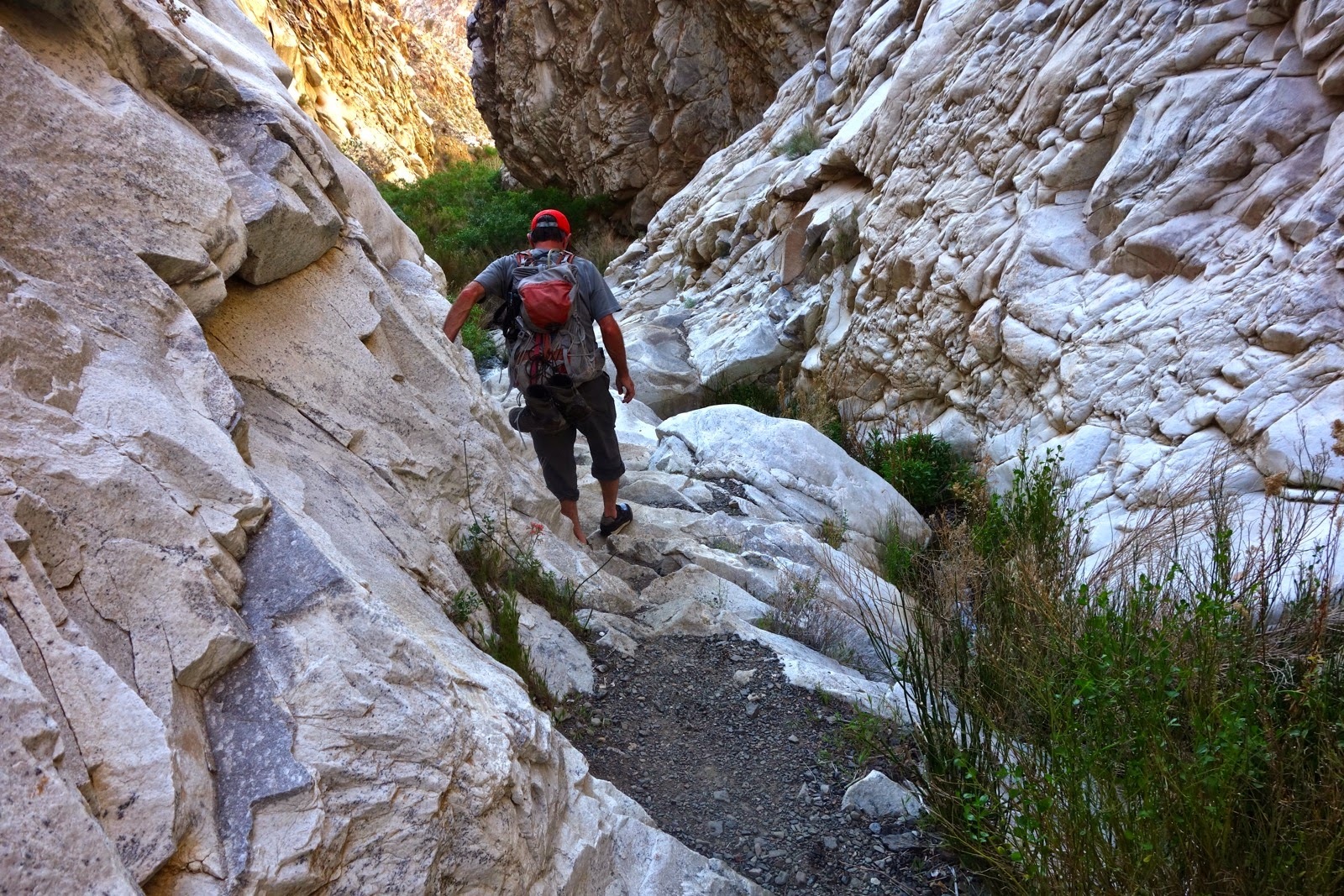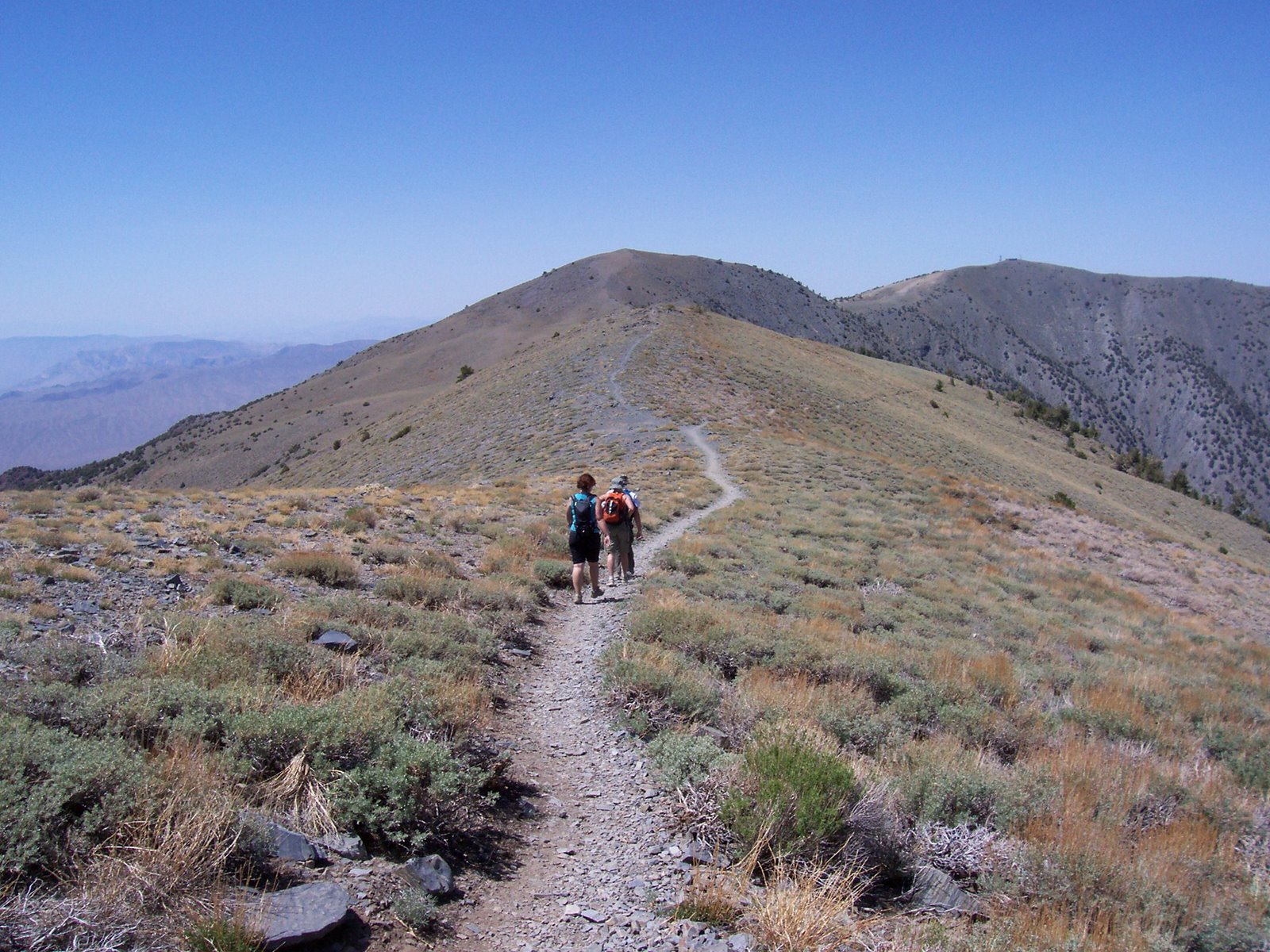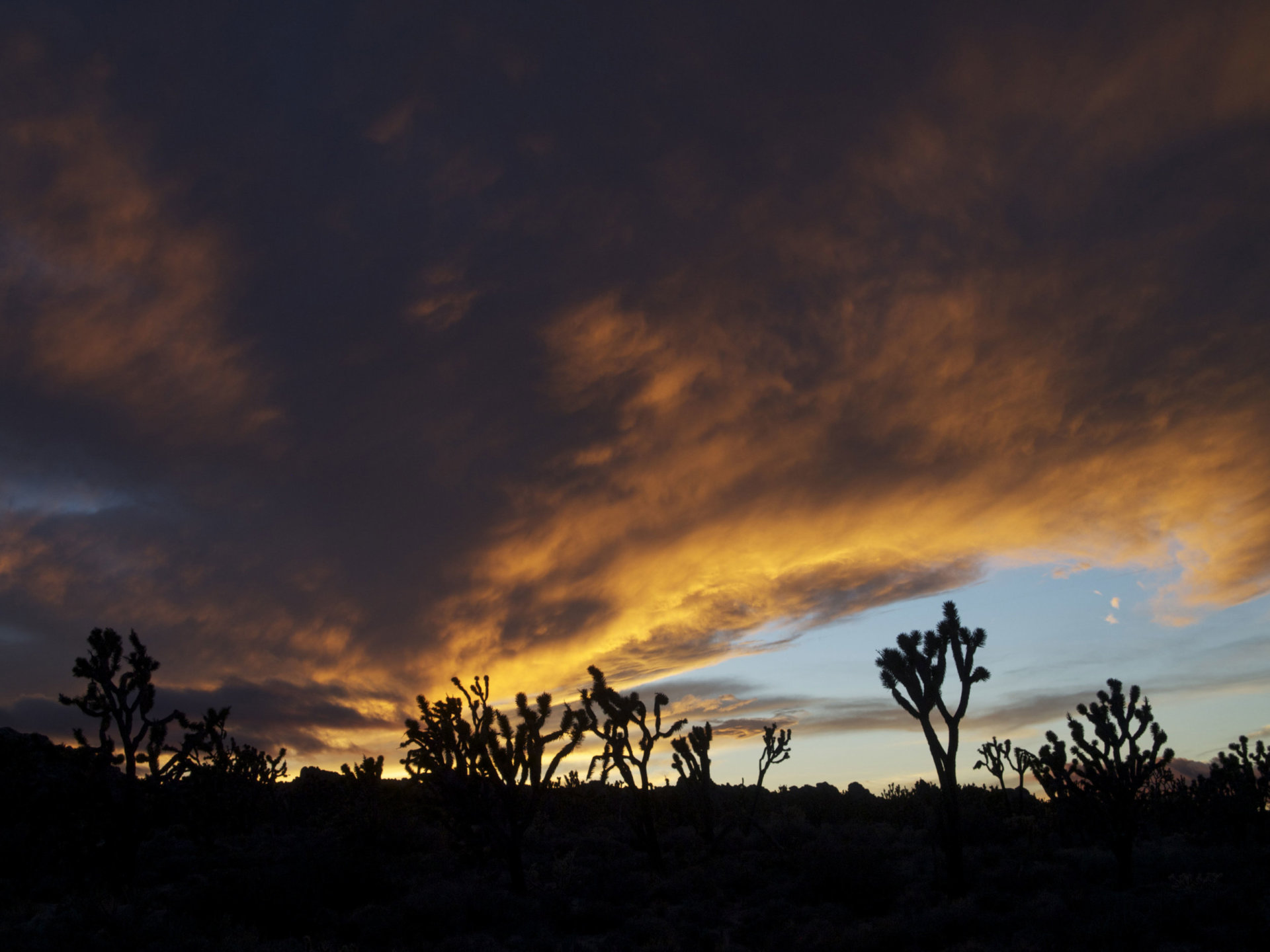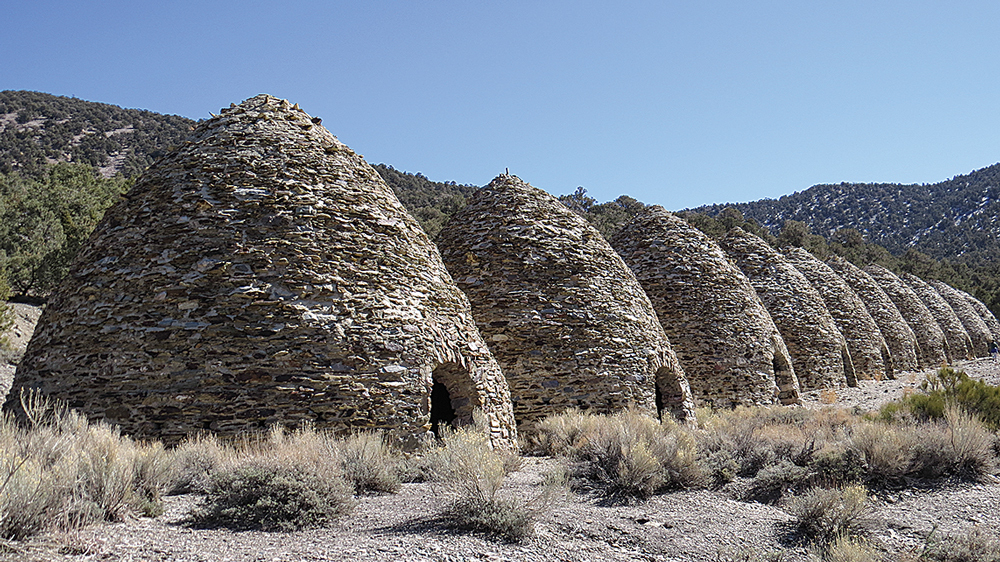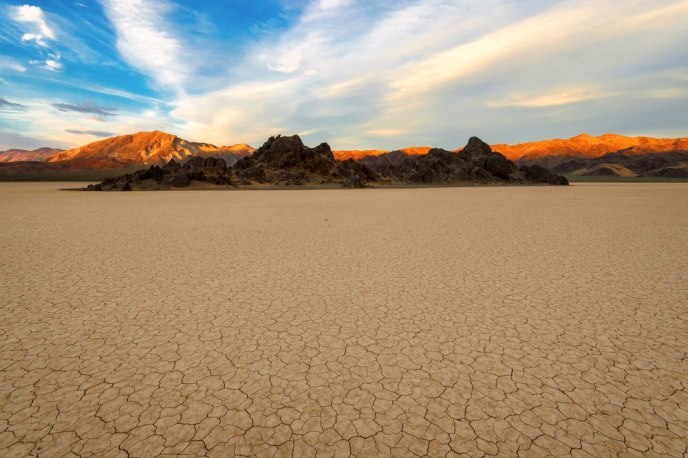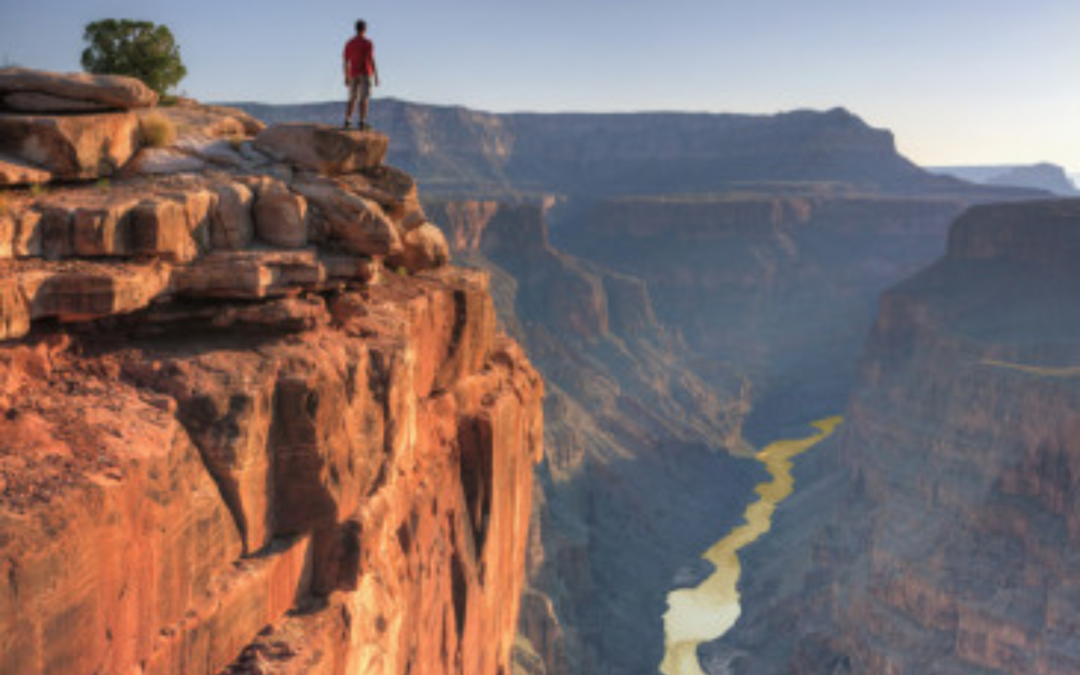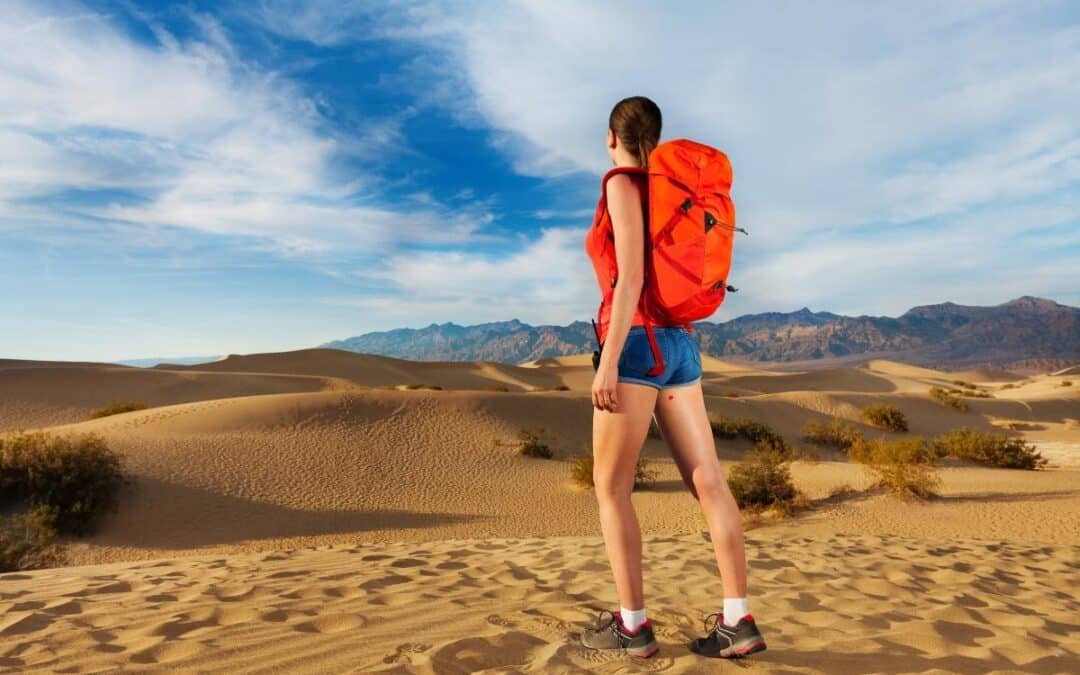
by The Goat | Oct 2, 2023 | Backpacking, Death Valley
As the summer heat wanes and the leaves start to fall, the vast expanse of Death Valley reveals a different facet of its beauty. Imagine setting out on a luxurious backpacking adventure in the heart of this natural wonder, with crisp, comfortable weather as your companion.
Fall brings with it cooler temperatures and less crowded trails, making it an ideal time to explore the breathtaking landscapes of Death Valley.
Our guided tours are designed with luxury in mind. This ensures that you get the most out of your backpacking experience. And with the added touch of our gourmet outdoor meals, expertly prepared by our chef, your journey through Death Valley will be extraordinary.
Here are some reasons why fall is a great time to go on our Death Valley backpacking tours.
The Starry Nights
In the fall, the skies over Death Valley come alive with countless twinkling stars, inviting you for an amazing stargazing experience. The clear, crisp nights offer uninterrupted views of the cosmos.
As you lay back in your state-of-the-art goose-down sleeping bag, you’ll find comfort, warmth, and an unparalleled view of the night sky. The experience is pure magic, taking the luxury of our Death Valley backpacking tours to a new level.
Outdoor Comfort
One of the best parts about our Death Valley backpacking tours is the comfort you’ll experience. We provide raised Helinox cots for sleeping – they’re like your bed at home but in the great outdoors. These cots are set off the ground, giving you a comfortable, clean, and cozy place to rest after a day of exploration.
Plus, the crisp fall air makes snuggling into your cot an absolute delight. Whether watching the stars at night or waking up to the first light of dawn, you will have an extraordinary outdoor experience on our Death Valley backpacking tours.
Gourmet Dining in Nature
Experience the joy of dining under the open skies with our luxury backpacking tours. Fall is a special time, offering an abundance of fresh, seasonal ingredients that our chef uses to create five-star cuisine.
Picture yourself savoring a gourmet meal designed with the season’s best produce right in the heart of Death Valley. Each dish is expertly paired with a fine drink, enhancing the flavor and dining experience.
These aren’t your typical campfire meals – they’re culinary masterpieces designed to delight your taste buds after a day of adventure.
Enjoy Moderate Temperatures
Fall in Death Valley is a breath of fresh air after a long, hot summer. Gone are the scorching temperatures; in their place, you’ll find a much more comfortable climate for exploring the great outdoors. The reduced heat makes it easier to trek through the stunning landscapes and truly enjoy the beauty around you.
Check Out Our Death Valley Backpacking Tours!
Do you want a unique and enjoyable outdoor experience? If so, it’s time to check out our Death Valley backpacking tours!
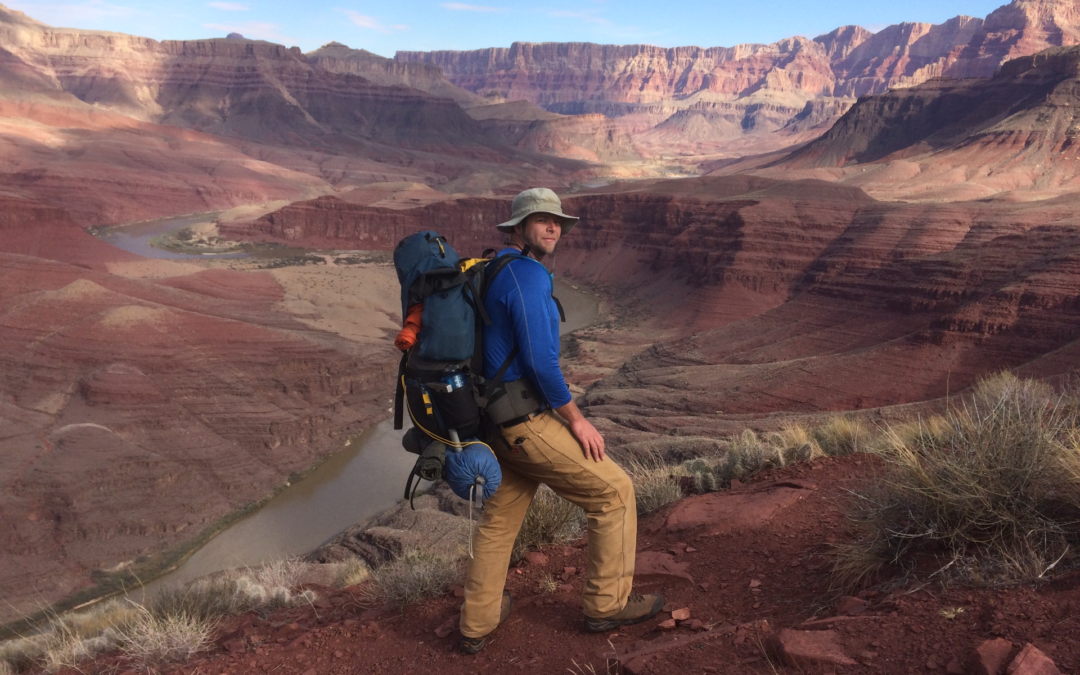
by The Goat | Mar 26, 2020 | Backpacking, Grand Canyon, Hiking, National Parks, Rim-to-Rim Grand Canyon
What are the Best Backpacking Trips in Grand Canyon?
Grand Canyon National Park can be a nearly overwhelming place. What do I do? Where should I go? Even for seasoned backpackers, the choices can be endless and exhausting. The Goat has compiled a list especially for you, outlining backpacking trips in Grand Canyon for all skill and experience levels. Enjoy!
5. The Hermit Loop
Time: 3 days, 2 nights
Distance: 18 miles
Difficulty: Undergraduate+ (Check out our difficulty ratings)
The Hermit Loop is a truly classic Grand Canyon backpacking trip that can be easily accomplished over a long weekend. It is a great hike for those who are looking to take their first backpacking foray into the big ditch, and truly hits all the highlights. Sweeping vistas, interesting side trips, and excellent canyon history await on a trail forged originally by the “hermit of the Grand Canyon”, Mr. Louis Boucher. The route was later improved by the Santa Fe Railroad Line in an attempt to bring mining, then tourism, into the area.
4. Tuckup Canyon via the Stairway to Heaven
Time: 7 days, 6 nights
Distance: 45 miles
Difficulty: PhD+ (check our difficulty ratings)
Get your defibrillator, this one is not for the faint of heart. Located in one of the most remote parts of Grand Canyon, this long, challenging loop is meant for experienced cannoneers only. This route takes ambitious hikers down Tuckup Canyon, past Shaman’s Gallery (recognized as one of the most spectacular rock art etchings in the American Southwest), through a traverse along the mighty Colorado River, and then up Stairway Canyon. Along the way, there are exciting climbing, route-finding, and scrambling challenges, and . Strap in!
3. Thunder River to Deer Creek
Time: 4 days, 3 nights
Distance: 28 miles
Difficulty: Graduate+ (check our difficulty ratings)
The Thunder River to Deer Creek Loop is perhaps the North Rim’s most fabulous backpacking trip. Multiple water sources, outstanding scenery, and a truly thunderous river. Geologically speaking, Thunder River is one of the most unique features in Grand Canyon. It begins as an underground river (aquifer) up on the Kaibab Plateau. It flows along various fault lines and crustal weaknesses until it breaks loose at the contact of the permeable Esplanade Group (mostly shales) and the impermeable Redwall Limestone, quite literally thundering onto the rocks below.
2. Rim-to-Rim via Phantom Ranch
Time: 3 days, 2 nights
Distance: 19 miles
Difficulty: Graduate (check our difficulty ratings)
This is the true Grand Canyon classic backpacking trip. Starting at the North Rim, your descent begins on the North Kaibab Trail as it winds it way down to the Colorado River. Along the way hikers are treated to unspoiled views, soaring eagles, and a well-developed trail. Thru-hikers may camp at Bright Angel Campground, or stay in the lodge at the famed Phantom Ranch. From here hikers may choose to ascend either the South Kaibab Trail (shorter, steeper) or the Bright Angel Trail (more miles) and stay the second night on the Esplanade. After cresting on the South Rim, be sure to gaze upon your North Rim starting point. This is one of the most popular trips in Grand Canyon, so be sure to make your reservations early!
1. The Escalante Route
Time: 5 days, 4 nights
Distance: 35 miles
Difficulty: PhD (check our difficulty ratings)
Carved by early Puebloan explorers of Grand Canyon, this long traverse of Grand Canyon from the Tanner Trail to Horseshoe Mesa and Grandview is perhaps one of the finest backpacking trips on the planet. There is a little bit of everything Grand Canyon here, as hikers will encounter outrageous views of the Great Unconformity, sandy beaches, a class 3 scramble over the famous Papago Wall, and a spectacular slot canyon carved from billion-year-old Shinumo Quartzite. This route confronts with hikers with the unimaginable scale of Grand Canyon, as it will seem as though you are climbing mountains in a canyon. Grand!
Going Guided
Hiking and exploring The Wave, or any of our public lands, is a special experience. Although it is possible to see these places yourself, hiring a guiding outfitter is a great idea. For instance, guiding services provide logistical support, and plan everything for your best possible trip. They provide a great safety net on the trail, and are trained in backcountry medicine. Above all, they provide a depth of knowledge of the region that turns a walk into a true adventure.
Canyons and Chefs provides all of the support you need, and pairs that with professional chefs and expert geologist/guides. Our meals use fresh ingredients and are inspired by local farms, culture, and cuisine. We utilize a mobile professional kitchen as a backbone for cooking over the fire. Furthermore, we provide top-of-the-line gear and passion for the places we explore. In conclusion, you can these wild places, but going with a guide can create an even more memorable experience. Don’t be shy, and call us!
Read our blog!
For adventure Chef-Driven Outdoor Experiences, see our epic tours in Grand Canyon, Utah, and Arizona!
Follow us on Facebook and Instagram
Explore Further, Be Wild, Eat Like Kings —
Canyons and Chefs
by The Goat | Mar 12, 2020 | Backpacking, Food, Hiking
Food for the Trail, Food For Life
We expend quite a lot of energy out on the trail, and all of those calories need to be either front-loaded or replaced. How do we do that? We eat food and drink water. Here, you will find recipes that link with Blue Marble Adventure GeoTourism’s Diet and Fitness regimen for being in great trail-shape. I have used some box mixes and premade sauces to make you life easier, you have enough to worry about training and eating right! Bon Apetit!
To see the exercise regimen that goes with this diet visit www.bluemarblegt.com/blog
Week 1:
Day 1:
Chocolate-Banana Smoothie
2 fresh bananas
1/4 c. cocoa powder
2 c. plain almond mild, unsweetened
1/2 c. water
1/2 plain nonfat greek yogurt
1 c. power greens mix
Place bananas, powder, almond milk, and yogurt in a blender. Puree on high until well combined. Add greens and puree until pulverized. Serve immediately. Reserve extra in the refrigerator.
Toasted BLAT with Turkey Bacon on Sourdough Bread
2 slices sourdough bread
6 strips turkey bacon
4 slices Roma tomato
2 leaves Romaine lettuce
1 avocado
Preheat oven to 300-degrees. Place turkey bacon on roasting pan, and roast in oven for 10 mins, or until bacon is golden brown and crispy. Slice and pit avocado, cut each half into quarters. Toast bread to liking. Spread 1/2 of the avocado onto each slice. Build sandwich with bacon, tomatoes, lettuce, and remaining avocado. Serve immediately
Classic Pizza Neopalitana w/ Whole Wheat Crust
1 package whole wheat pizza dough
1 jar high-quality marinara sauce
1 package fresh mozzarella cheese
1 sprig fresh basil
Preheat oven to 425-degrees. If you have a backing stone, preheat it along with the oven. On floured surface, shape dough into a circle. With a rolling pin, roll out evenly, flouring liberally until desired thickness and shape is achieved. Spread sauce evenly. Slice mozzarella evenly, add to pizza. Bake for 14-16 mins, or until dough is crispy and cheese is melted completely. Pick and tear basil leaves, spread on pizza. Serve immediately.
Day 2:
Berry Peachy Smoothie
1/4 bag frozen mixed berries
1/4 bag frozen peaches
2 c. almond milk
1/2 c. water
1/2 c. nonfat plain greek yogurt
1 c. power greens mix
Place fruit, almond milk, and yogurt in a blender. Puree on high until well combined. Add water to get desired consistency. Add greens and puree until pulverized. Serve immediately. Reserve extra in the refrigerator.
Flaxseed Pancakes with Blueberry-Maple Syrup and Honey Butter
Organic Flaxseed Pancake Mix
1 c. fresh blueberries
3 c. Maple Syrup
1/2 c. butter
2 oz. honey
Bring butter to room temperature. Add honey, whisk vigorously until combined and chill. In small saucepan, heat small amount of butter, add blueberries and small amount of water. Cook until berries become soft and begin to break down. Add syrup and simmer for 5 minutes. Prepare pancakes according to instructions on box and serve with warm syrup and cool butter.
Grilled Eggplant and Couscous salad with Roasted Green Chili Vinaigrette
1 eggplant, sliced, grilled, and diced
1 cup cooked couscous
1 cup roasted green chilies
3 oz. olive oil
1 oz. lemon juice
Salt and pepper to taste
Combine chilies, oil, and lemon juice in a small bowl, whisking to combine. Combine couscous and eggplant, and dress with vinaigrette. Serve immediately.
Seared Alaskan Salmon w/ Caramelized Vegetable Quinoa and Avocado Butter
6 oz. salmon fillet, de-boned
1 onion, diced
1 red pepper, diced
1 zucchini, diced
1 c. cooked quinoa
1 avocado, pitted and smashed
1 bunch cilantro, chopped
1 lime, juiced
1/2 c. unsalted butter, softened
Add avocado, cilantro, and lime juice to butter and combine thoroughly. Preheat oven to 425-degrees. In a skillet, heat small amount of olive oil and add onion, pepper, and zucchini, cooking on low heat until vegetables are browned and sweet. In a different skillet, heat small amount of olive oil to smoke point and add salmon, skin-side down. Cook until edges begin to brown, and put in oven for 5 mins. or until slightly firm. Add quinoa to vegetables and heat. To serve, place quinoa on plate, place salmon on quinoa skin-side up, and put small pad of butter on the salmon. Serve immediately.
Day 3:
Pineapple-Mango Smoothie
1/4 bag frozen pineapple
1/4 bag frozen mango
2 c. almond milk
1/2 c. water
1/2 c. nonfat plain greek yogurt
1 c. power greens mix
Place fruit, almond milk, and yogurt in a blender. Puree on high until well combined. Add water to get desired consistency. Add greens and puree until pulverized. Serve immediately. Reserve extra in the refrigerator.
Veggie-Stuffed Egg Bake with Boursin Cheese
3 eggs
1/2 c. broccoli florets
1/2 c. mushrooms
1/4 c. tomatoes
2 tsp. boursin cheese
1 tsp. cooking oil
Preheat oven to 350-degrees. Saute vegetables in cooking oil using a cast iron skillet. Whisk eggs until well combined and pour over vegetables. Add cheese. Cook in oven until eggs are set.
Whole Wheat Blueberry-Chocolate Chip Muffins
2 c. whole wheat flour
2 tsp. baking powder
1 tsp. salt
2 eggs
1/2 c. butter, melted
1 c. sugar
1 tsp. vanilla extract
1 c. fresh blueberries
1/2 c. chocolate chips
Preheat oven to 350-degrees. In a large mixing bowl add eggs, butter, sugar, and extract. Whisk until creamy an combined. Though a sifter add flour, baking powder, and salt. Whisk lightly into batter. Fold in blueberries, and chocolate chips. Spray a muffin tin with oil. Using 1 full ice cream scoop, portion batter into tin. Bake for 15-20 mins., or until toothpick inserted into center comes out dry. This recipe makes roughly 24 muffins, or two full muffin tins.
French Onion Soup with Gruyere Crouton
4 onions, sliced
2 tsp. butter
4 oz. brandy or cognac
8 oz. cans beef stock
8 oz. chicken stock
1 tsp. salt
Slices French bread
2 slices gruyere cheese
In a stock pot, melt butter and add onions and brandy. Cook onions on low heat until onions are very brown and sweet. Add stock and simmer for 30 mins. Add salt to taste.
For the Croutons: Add cheese to bread, bake in oven for 8 mins. or until cheese is melted and bread is crispy. Add to soup.
Caprese Salad w/ Fresh Mozzarella and Heirloom Tomatoes
2 Roma tomatoes, sliced
1 ball mozzarella cheese
2 sprigs fresh basil
1 oz. extra virgin olive oil
1 oz. balsamic vinegar
Arrange tomato and cheese slices in an alternating pattern. Season with salt, pepper, olive oil, and vinegar. Finish with torn basil and serve immediately.
Grilled Chicken Caeser Salad with Parmigian Croutons
1 chicken breast,grilled and cubed
1 head romaine lettuce
3 oz. low-fat Caesar dressing
1 bag Caeser croutons
Season and grill chicken until juices run clear. Chop lettuce, add croutons. Dress and combine. Add chicken. Serve immediately.
Day 4:
Strawberry-Coconut Smoothie
1/2 bag frozen strawberries
1 c. coconut milk
1 c. almond milk
1/4 c. water
1/2 c. nonfat plain greek yogurt
1 c. power greens mix
Place fruit, almond milk, and yogurt in a blender. Puree on high until well combined. Add water to get desired consistency. Add greens and puree until pulverized. Serve immediately. Reserve extra in the refrigerator.
Frozen Raspberry “Custard”
1 cup frozen raspberries
1/2 cup whole milk
In a bowl, add milk to berries and let sit for 2 mins. Serve immediately.
The Goat’s Cobb Salad
1/4 small bag shredded lettuce
1/4 small bag shredded purple cabbage
1 hardboiled egg, sliced
1 oz. goat cheese
1/2 c. dried cranberries
1/2 c. shelled, crushed walnuts
2 strips turkey bacon, crumbled
1 oz. balsamic vinaigrette
Combine lettuce and cabbage. In parallel lines, garnish salad with remaining ingredients. Dress with vinaigrette.
Health Nut Trail Mix
2 parts skin-on almonds
1 part flax seed
2 part shelled sunflower seed
2 parts pepitas
2 parts roasted pumpkin seeds
2 parts shelled walnuts
2 parts dried cranberries
2 parts dried apricots
1 part roasted oats
Coconut Red Curry Chicken w/ Basmati Rice
1 boneless, skinless chicken breast, grilled and cubed
2 tsp. cooking oil
1/2 c. broccoli, chopped
1/2 c. cauliflower, chopped
1/3 c. carrots, chopped
1/3 c. onion, chopped
2 cloves garlic, chopped
1 can coconut milk
2 tsp. red curry paste
Saute all vegetables with curry paste until translucent. Add cubed chicken. Add coconut milk, simmer until thickened. Serve while hot.
Day 5:
Peach Tahini Smoothie
1/2 bag frozen peaches
2 tsp. tahini paste
2 c. almond milk
1/2 c. water
1/2 c. nonfat plain greek yogurt
1 c. power greens mix
Place fruit, tahini, almond milk, and yogurt in a blender. Puree on high until well combined. Add water to get desired consistency. Add greens and puree until pulverized. Serve immediately. Reserve extra in the refrigerator.
Whole Wheat Waffles w/ Rum-Maple Syrup and Honey Butter
For the cakes:
1 c. whole wheat flour
1 tsp. baking powder
1/2 c. milk
2 tbsp. white sugar
1/4 c. melted butter
1/4 tsp. salt
In a large mixing bowl add butter, and sugar, whisking until combined. Whisk in milk. Though a sifter add flour and baking powder. Whisk lightly until combined, let batter sit for 5 mins. In a lightly oiled waffle iron, add batter and cook until done on the inside and crispy on the outside. Top with syrup and butter. Serve immediately.
For the Syrup:
2 shots rum
1 c. maple syrup
Heat a small saucepan. Add rum and cook out alcohol, simmering for at least 5 minutes. Add syrup, and simmer for additional 5 minutes
For the butter:
2 oz. honey
1/2 unsalted butter, softened
Whisk honey into softened butter and chill.
Fruit n’ Nut Grab Bag
2 parts roasted walnuts
1 part dried apricots
1 part dried cranberries
1 part dried nectarines
1 part dried apple
1 part dried strawberry
2 part pepitas
1 part roasted pistachios
Smoked Salmon and Dill Quesadilla
2 large flour tortillas
1/2 lb. smoked salmon,
2 c. Gouda cheese, shredded
1 sprig fresh dill, picked
Sour cream for garnish
Heat a griddle to medium heat and oil lightly. Lay tortillas flat, and spread cheese on top. Cook until cheese is melted and tortilla is crispy. Add salmon, cook until salmon is heated, roughly 1 min. Add dill, close the tortillas, remove from heat. Garnish with small amount of sour cream and serve immediately.
The Goat’s Fruit Salad
1 small watermelon
1 small cantaloupe
2 cups strawberries
2 cups grapes
1 sprig fresh mint, chopped
3 cups nonfat vanilla yogurt
Remove the rind and cube the melons. Add remaining fruit, mint, and yogurt. Fold until all fruit is covered. Will keep for up to five days when chilled and covered.
Fire-Grilled Turkey Burger w/ Sonoran Coleslaw
For the slaw:
1 cup shredded purple cabbage
1/2 c. shredded carrot
1/4 c. diced green chilies
1/4 c. thinly-sliced apple
2 tsp. rice vinegar
For the burger:
Whole wheat hamburger buns
1 lb. ground turkey
2 tsp. applesauce
1 tsp.Worcestershire sauce
1 tsp. dijon mustard
1 egg
1 tbsp. cornmeal
Combine all ingredients in a mixing bowl. Grill until juices run clear. Top with slaw and serve on buns.
Day 6:
Strawberry-Mango Smoothie
2 c. almond milk
1/2 c. water
1/2 c. nonfat plain greek yogurt
1 c. power greens mix
Place fruit, almond milk, and yogurt in a blender. Puree on high until well combined. Add water to get desired consistency. Add greens and puree until pulverized. Serve immediately. Reserve extra in the refrigerator.
Cereal Nut Mix
2 parts Cinnamon Toast Crunch
2 parts Golden Grahams
2 parts Honey Nut Cheerios
1 part Slivered almonds
2 parts Kix
1 parts dried pears
The Goat’s Tuna Salad w/ Rye Toast
2 c. chunk tuna, drained
2 tsp. light mayonnaise
3 stalks celery, diced
1/2 c. chopped green grapes
1/4 c. chopped cranberries
1 tsp. ground caraway seed
Salt and pepper to taste
Place all ingredients in a large mixing bowl and stir well until combined.
Banana Walnut Bread
3 c. AP flour
2 tsp. baking powder
1/2 tsp. salt
3 eggs
1 c. unsalted butter, melted
1/2 c. sugar
1/2 c. brown sugar
1.5 c. smashed bananas
1 c. shelled walnuts
Preheat oven to 325-degrees. In a large mixing bowl add butter, eggs, sugar, and beat until well combined. Add bananas, and beat until combined. Through a sifter, add flour, baking powder, and salt. Mix on low setting until combined dough is formed. Fold in walnuts. Bake for 55-60 mins., or until toothpick inserted in center comes out dry.
Shrimp Scampi w/ Whole Wheat Pasta
1/2 pckg. whole wheat linguini
1/2 lb. raw shrimp, peeled and deveined
1/2 onion, sliced
3 cloves garlic, sliced
1 c. dry white wine
1 lemon, juiced
1/4 c. unsalted butter
Cook pasta to al dente and set aside. Heat small amount of butter and sauce onions and garlic until onions are brown and taste sweet. Add wine, and reduce by half. Add lemon juice. Add shrimp and simmer until pink and firm. Spoon sauce and shrimp over warm pasta and serve immediately.
Day 7:
Mountain Berry Smoothie
1/2 bag frozen mixed berries
2 c. almond milk
1/2 c. water
1/2 c. nonfat plain greek yogurt
1 c. power greens mix
Place fruit, almond milk, and yogurt in a blender. Puree on high until well combined. Add water to get desired consistency. Add greens and puree until pulverized. Serve immediately. Reserve extra in the refrigerator.
May The Goat be always with you
For trips through geologic time visit www.bluemarblegt.com
Follow The Goat on Twitter: twitter.com/bluemarblegt
and on Instagram at instagram.com/bluemarblegoat
Like our Facebook page at Facebook.com/bluemarblegt
by The Goat | Mar 12, 2020 | Backpacking, Death Valley, Geology, Hiking, National Parks
Death Valley: 10 Cool Facts at 134 Degrees
There is a place so vast, so beautiful, so unique, and so special that it nearly defies comprehension. This is Death Valley. Located in the howling wilds of the Mojave Desert along the border of California and Nevada, Death Valley is at the same time magnificent and overwhelming in sheer size, beauty, and adventure opportunity. In our opinion, it is world-famous for all the wrong reasons. When most think of Death Valley, they think of it being the place where the hottest temperature on Earth was recorded; 134 degrees Fahrenheit to be exact on July 10, 1913. Even the name itself conjures up images of things literally bursting into flames; a place that is at the least not enjoyable, and at the worst, the terrestrial version of The Inferno.
While Death Valley itself does hold that distinction, the surrounding areas are quite pleasant during the summer months, and see up to feet of snow in the winter. The Goat aims to shed some new light on this wondrous, mysterious, gorgeous, and astonishing area, and he has put together his very best “Did You Know?” list about Death Valley!
1. Did you know that the vertical distance between the lowest and highest points in Death Valley is over 11,000 feet?
Telescope Peak, the highest peak in the Panamint Mountains that tower over Death Valley, is 11,049 feet above sea level. Its lofty peak is less than 15 miles away from the lowest point in North America, Badwater Basin at 282 feet below sea level. This nearly incomprehensible juxtaposition is a feat that is only accomplished by the complex tectonics and unique geology that govern Death Valley’s highs and lows.
2. Did you know that Death Valley should really be called “Life Valley?”
Death Valley National Park is home to numerous lizard and reptile species, bighorn sheep, antelope, snakes, Gila monsters, mountain lions, coyotes, foxes, several species of owl, rodents, and hundreds of plant and tree species including cottonwood, oak, Joshua trees, and various pines, as well as many species of cactus. The perception that it is a barren, lifeless desert could not be further from reality, as it houses one of the greatest biologically diverse ecosystems in the world.
3. Did you know that you can play golf then soak in hot springs in Death Valley?
You and the Devil. Furnace Creek Golf Club boasts a full 18-hole course that challenges golfers of all levels, and the Devil’s Golf Course is one of the most excellent salt flats in the world. Visitors to Death Valley can easily see both in a day, so get ready to dance with the Devil! After dancing, feel free to soak luxuriously in Furnace Creek Hot Springs, the park’s developed and fantastically rejuvenating hot natural hot spring.
4. Did you know that Death Valley is the largest National Park in the contiguous 48?
At 3.4 million acres, it dwarfs many of our National Parks including Grand Canyon, Yosemite, and even Yellowstone in sheer size. In fact, Grand Canyon and Yellowstone together would fit inside Death Valley!
5. Did you know that one of Earth’s rarest species exists in Death Valley?
The Devil’s Hole Pupfish, one of the most rare and beautiful species of fish in the world, exists in Death Valley and only Death Valley. In fact, the park is home to several species that are not just indigenous, but exist here almost exclusively.
6. Did you know that Mt. Whitney is in the next mountain range over?
Mt. Whitney, the highest peak in the contiguous 48 states at 14,465 feet above sea level, lies in the Sierra Nevada just west of Death Valley. This means that the highest and lowest points in the lower 48 are less than 100 miles apart!
7. Did you know that in 1929, not a single drop of rain fell in Death Valley?
Yep, not one. Death Valley is the driest place in North America, averaging less than 5 inches of rain per year. The howling deserts of places like Arizona and even the Sahara Desert of Africa average more, making Death Valley one of the driest places on the globe.
8. Did you know that Death Valley is home to some of the best-preserved human history sites in the Unites States?
Both modern and ancient history are on fabulous display here in Death Valley. Archaeological evidence dates back to over 9,000 years ago, as petroglyphs and various Puebloan artifacts can be found all over the park. In addition, the Timbisha Shoshone Native American Tribe has called Death Valley home for over 1,000 years. There is colorful mining and European history here as well, as Death Valley got its name from frustrated and thirsty prospectors in 1848. There are numerous well-preserved mining claims and historical artifacts, and even a wickedly cool ghost town! (Check out our Surprise Canyon Backpacking Tour)
9. Did you know Death Valley is a favorite for Hollywood movie sets?
Dozens of scenes from Star Wars have been filmed in Death Valley, including Artist’s Palette (the Sandcrawler scene from Star Wars Episode IV: A New Hope), Golden Canyon (Jawa scenes from Star Wars Episode IV: A New Hope) and Mesquite Flat Sand Dunes (Droid scenes from Star Wars Episode IV: A New Hope). Also, cult classic film Tremors was filmed in the Owens Valley just one range over, and many of the shots in this excellent movie gaze onto the west side of the Panamint Mountains. Check out The Goat’s Geology Blogto learn more about Tremors and other great geology movies!
10. Did you know that Death Valley has some of the most outrageous geology in the world?
The geologic display in Death Valley is nothing short of astonishing. Home to three major faults, Death Valley is a wild melange of nearly-billion year-old sediments (very rare), contorted metamorphics, twisted volcanics, and more mineralization and hydrothermal staining than you could shake a geologic hammer at. A quintessential example of the extensional tectonics that have created the Basin and Range Province, Death Valley is not to be missed by the geologist child in all of us.
Bonus: Did you know that Death Valley can be a great place in all seasons (even summer)?
You read that right; all seasons, even summer. Crazy? Ridiculous? Suicidal? Nope, just the truth. The Panamint Mountains, which reach to over 11,000 feet, stay cool even as the summer heat blisters the valley below. This is a perfect time to summit many of Death Valley’s most lofty peaks, including Telescope Peak, it’s highest point.
Blue Marble Adventure GeoTourism is ecstatic to be rolling out our guided Death Valley hiking tours! Let our geologist/guides show you the wonder and whimsy of one of the most fantastically outrageous places on the face of the Earth. You’ll be glad you got past the name and into the wild!
May The Goat be always with you




